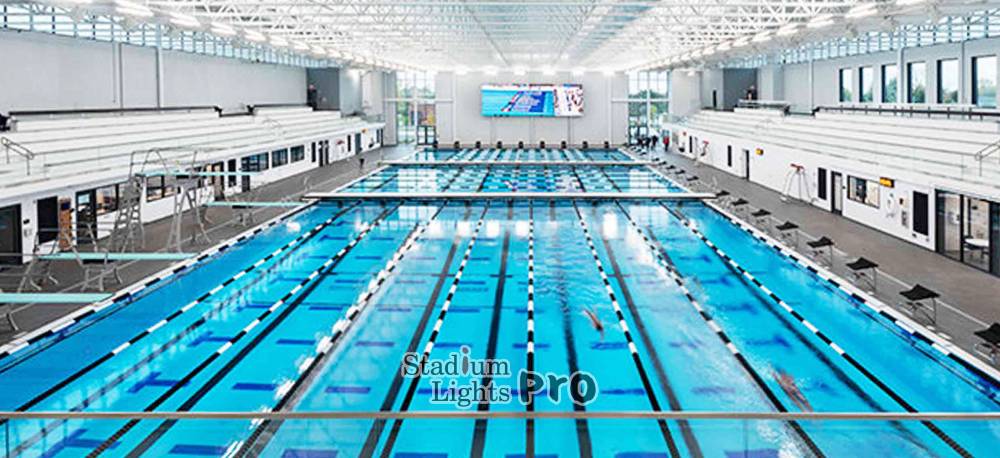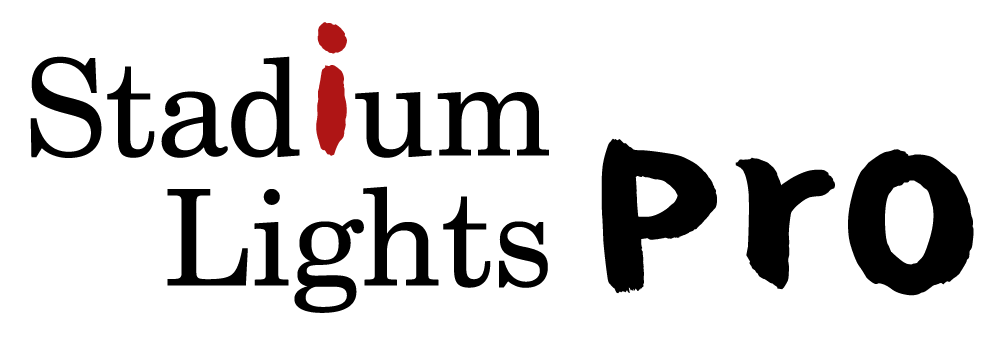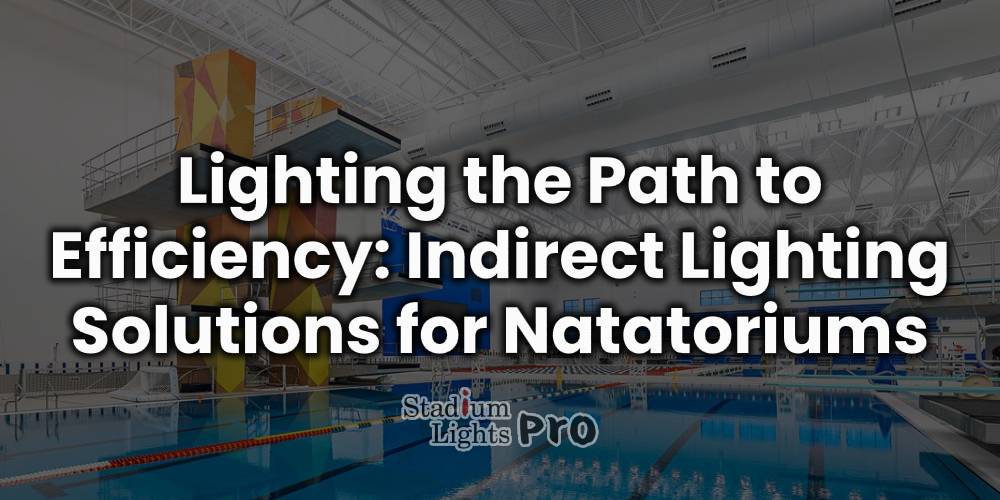Lighting in natatoriums, or indoor swimming pools, often presents unique challenges. Not only must it meet the practical needs of the space—such as providing adequate visibility for swimmers and lifeguards—but it must also consider the comfort of users, energy efficiency, and maintenance costs. Indirect lighting, a technique that aims to diffuse light and reduce glare, offers a solution to these challenges. However, implementing this type of lighting in natatoriums requires overcoming certain issues to maximize its benefits.

Table of Contents
ToggleWhat is Indirect Lighting?
Indirect lighting refers to a technique where light is directed towards a surface, such as the ceiling or walls, and is then reflected into the surrounding space. This results in a soft, diffuse illumination that helps reduce harsh shadows and minimizes glare. Unlike direct lighting, where the light source is aimed directly at the area to be illuminated, indirect lighting scatters the light across the room, providing a more even, gentle distribution of light.
In natatoriums, indirect lighting is particularly beneficial. The harsh glare that comes with direct lighting can be uncomfortable for swimmers and disrupt the peaceful atmosphere of the pool. By using indirect lighting, the harshness of direct illumination is avoided, creating a more relaxing and visually comfortable environment. The diffusion of light also helps illuminate the entire space evenly, preventing dark corners or overly bright spots that can create a disorienting or unsafe experience for those using the pool.
Moreover, indirect lighting contributes to the energy efficiency of a natatorium. Traditional lighting methods often require multiple fixtures to achieve sufficient brightness, leading to higher energy consumption. Indirect lighting, on the other hand, can reduce the number of fixtures needed while still providing adequate illumination. The light’s reflection from walls or ceilings spreads it across a wider area, reducing the need for high-powered, energy-draining light sources.
Indirect lighting is a particularly effective solution for spaces like natatoriums, where the goal is to combine functional lighting with energy efficiency and user comfort. The technique not only reduces the glare that can distract swimmers but also plays a role in optimizing energy use and improving the overall quality of the lighting.

The Importance of Energy Efficiency in Natatorium Lighting
Natatoriums, by their very nature, require large amounts of illumination. These spaces are typically designed to be open and expansive, with high ceilings and extensive areas that need to be well-lit for safety and functionality. The need for consistent, bright lighting during operational hours often translates to high electricity consumption, making natatoriums one of the more energy-intensive facilities to maintain.
In addition to the operational costs associated with lighting, the constant illumination needed for safety purposes can place a strain on the environment. Traditional lighting systems, especially those that rely on incandescent or fluorescent bulbs, can be inefficient and wasteful, consuming more power than necessary and producing excessive heat. This inefficiency increases the load on the building’s electrical system, further driving up operating costs.
The solution lies in optimizing the lighting design to focus on energy conservation without compromising the functional requirements of the space. Indirect lighting offers a means to achieve this balance. By diffusing light over larger surfaces such as the ceiling and walls, the need for multiple light fixtures can be reduced. A lower number of fixtures, combined with more effective light distribution, can significantly decrease the energy consumption of a natatorium.
Incorporating energy-efficient lighting technologies such as LED bulbs into the design can further enhance energy savings. LEDs consume far less energy compared to traditional lighting sources and have a longer lifespan, reducing both energy costs and the frequency of bulb replacements. LEDs also generate less heat, making them ideal for use in spaces where temperature regulation is important, such as natatoriums.
The focus on energy efficiency not only helps reduce operational costs but also aligns with broader sustainability goals. By minimizing energy consumption, natatoriums contribute to reducing their carbon footprint, promoting a more sustainable use of resources. As energy costs continue to rise and environmental concerns gain greater prominence, adopting energy-efficient lighting solutions will become even more critical for natatoriums looking to improve both their bottom line and their environmental impact.
Common Problems with Indirect Lighting in Natatoriums
While the benefits of indirect lighting are clear, its implementation in natatoriums comes with a set of challenges that need to be addressed to ensure the system works effectively. These issues range from improper fixture placement to the difficulty of maintaining lighting systems in a high-humidity environment. Recognizing and understanding these challenges is essential for creating a lighting design that enhances the functionality and sustainability of the natatorium.
Glare and Visual Discomfort
One of the most significant concerns with indirect lighting is the potential for glare. Although indirect lighting is generally softer than direct lighting, it can still create uncomfortable light levels if it is not properly controlled. The way light bounces off surfaces and reflects into the space can lead to uneven lighting distribution, with certain areas becoming too bright and others remaining too dim.
In natatoriums, glare can be especially problematic because it interferes with swimmers’ vision and can create a distracting or unsafe environment. For swimmers, clear visibility both in and out of the water is important, and excessive glare can make it difficult to see properly, leading to potential accidents or visual discomfort. Glare can also detract from the overall atmosphere of the space, causing eye strain for both swimmers and spectators.
To prevent glare, lighting designers must consider the positioning of fixtures and the materials used for reflective surfaces. Using diffusers and installing fixtures at strategic angles can help direct light away from areas where it might cause visual discomfort. Additionally, ensuring that the fixtures have proper shielding can further reduce glare while maintaining the effectiveness of the lighting system.
Inefficient Use of Fixtures
Another challenge with indirect lighting is the potential for inefficient use of fixtures. Installing too many fixtures or placing them incorrectly can lead to unnecessary energy consumption and an uneven distribution of light. If the fixtures are not carefully positioned based on the needs of the natatorium, the space may become either too bright or too dim in certain areas.
One common mistake is overusing fixtures in an attempt to provide enough light, especially in large, open areas such as the swimming pool deck. The result can be excessive energy consumption and wasted light. Indirect lighting is meant to spread light more evenly across a space, and when too many fixtures are used, this effect can be compromised.
To solve this problem, lighting designers must take a thoughtful, strategic approach to the placement and selection of fixtures. This includes considering the layout of the space, the size and shape of the pool, and the areas where light is most needed. By focusing on fewer, more effective fixtures, energy usage can be minimized while still ensuring that the space is well-lit and functional.
Maintenance and Durability
Natatoriums are exposed to high levels of humidity, chlorine, and other harsh chemicals used in water treatment. These environmental conditions can rapidly degrade lighting fixtures, causing them to corrode or malfunction. This presents a challenge for lighting systems in natatoriums, as the need for frequent maintenance or fixture replacements can result in higher costs and disruptions to pool operations.
Traditional lighting systems, such as incandescent and fluorescent bulbs, are particularly susceptible to these harsh conditions. These types of bulbs often require frequent replacements, and their exposure to moisture and chemicals can cause them to fail prematurely. The need for ongoing maintenance can add to the operational costs of running a natatorium, and any downtime associated with lighting failures can be inconvenient for swimmers and staff.
To address these issues, it is essential to choose lighting fixtures that are specifically designed for use in high-humidity environments. LED lights, for example, are more resistant to moisture and chemicals than traditional bulbs, making them a more durable choice for natatoriums. Additionally, opting for sealed or weatherproof fixtures can help protect the lights from corrosion and reduce the frequency of maintenance.
Incorporating easy-to-maintain systems, such as modular lighting designs that allow for easy bulb replacements, can also help minimize downtime and reduce the impact of maintenance on pool operations. By selecting the right materials and designs, natatorium operators can ensure that their lighting systems remain functional and cost-effective for the long term.
How to Solve the Problems of Indirect Lighting in Natatoriums
With proper planning and implementation, the challenges of indirect lighting can be overcome. By choosing the right materials, fixtures, and design strategies, natatoriums can benefit from energy-efficient lighting solutions that enhance the space while keeping operational costs in check.
Optimizing the Lighting Design
One of the most important steps in improving indirect lighting is optimizing the lighting design. This means carefully considering the layout of the natatorium and how the light will be distributed across the space. Light placement should avoid areas where glare might occur, such as directly above the water or near highly reflective surfaces.
Instead of scattering lights throughout the ceiling, a well-thought-out design places fewer fixtures that provide more uniform light coverage. Additionally, using a combination of ceiling-mounted and wall-mounted fixtures can help achieve a more balanced light distribution. By focusing on strategically placed light sources that bounce light off larger surfaces, the space can benefit from a more diffuse, comfortable lighting effect.
Choosing the Right Fixtures
Selecting the correct fixtures is essential in ensuring that indirect lighting performs well in natatoriums. High-quality, corrosion-resistant fixtures that are rated for use in high-humidity environments should be chosen to avoid frequent repairs or replacements. LED fixtures are often a preferred option for their longevity, lower energy consumption, and better control over light output.
Additionally, fixtures that allow for dimming or adjusting light levels give operators more control over the intensity of the lighting. This flexibility can help optimize energy consumption by providing bright light when needed and dimming it during quieter hours. Adjustable fixtures also allow for personalized settings that can create a more pleasant atmosphere for both swimmers and staff.
Utilizing Reflective Surfaces
The effectiveness of indirect lighting in natatoriums heavily relies on the surfaces off which light reflects. Choosing the right materials for walls, ceilings, and floors is crucial. Light-colored and highly reflective surfaces, such as white or light-toned finishes, help maximize the diffusion of light and improve the overall lighting quality. Dark-colored surfaces, on the other hand, absorb light, which can lead to inefficient use of energy and create uneven lighting patterns.
The ceiling is one of the most critical surfaces for indirect lighting, as it’s where light is typically directed. A smooth, light-colored ceiling helps bounce light throughout the space, reducing the need for multiple light sources. Additionally, reflective wall surfaces can direct light across the room, ensuring that areas are illuminated without the need for direct fixtures.
Energy-Saving Technologies
Incorporating modern energy-saving technologies into the lighting system can further improve efficiency. Smart lighting systems that incorporate motion sensors, daylight harvesting, and automated controls can drastically reduce energy usage. For example, motion sensors can turn lights on or off depending on whether someone is present, and daylight harvesting systems adjust the lighting based on the amount of natural light available.
By integrating these technologies, natatoriums can reduce energy consumption without compromising on the lighting quality needed for safety and comfort. These automated systems can be programmed to adjust lighting based on peak hours and usage patterns, ensuring the space is lit when needed and saving energy during off-peak times.
Reducing Glare with Proper Shielding
To combat glare, it’s essential to select lighting fixtures that include proper shielding. Fixtures with diffusers, louvres, or other glare-reducing mechanisms can prevent the harsh direct light that causes visual discomfort. In areas where glare is especially problematic, such as around the waterline or near windows, it’s important to install light sources that are positioned at the right angles to minimize direct light exposure.
Glare-reduction techniques can also be applied to the design of the lighting system. By carefully placing fixtures at strategic points along the walls or ceiling, designers can prevent the accumulation of light in spots where it would reflect into swimmers’ eyes or cause unwanted visual distractions. Additionally, dimming options can help adjust the brightness in specific areas to accommodate varying lighting needs.
Sustainable Materials and Energy-Efficient Solutions
Sustainability in lighting design is another crucial factor when considering long-term benefits. The use of energy-efficient materials and sustainable practices in the selection of lighting fixtures, surfaces, and design elements can contribute to both energy conservation and cost reduction. This includes choosing energy-efficient LED lighting, incorporating recyclable materials, and ensuring that all aspects of the lighting system are designed to minimize environmental impact.
Additionally, energy-efficient solutions, such as the use of solar panels to supplement lighting needs or geothermal energy for heating, can further support the goal of reducing a natatorium’s carbon footprint while providing high-quality illumination.
Implementing Indirect Lighting in Natatoriums
Implementing indirect lighting solutions requires collaboration between lighting designers, architects, and natatorium operators. By working together, they can create a customized lighting system that addresses the unique needs of the space. From considering the size and layout of the natatorium to choosing the right fixtures and materials, every detail plays a role in achieving energy efficiency and optimal lighting conditions.
The implementation of indirect lighting, with the right balance of design, materials, and technology, can transform the natatorium experience, making it more comfortable, sustainable, and cost-effective. Through thoughtful planning and innovative solutions, natatoriums can lead the way in reducing energy consumption while providing a better environment for swimmers, staff, and visitors.

